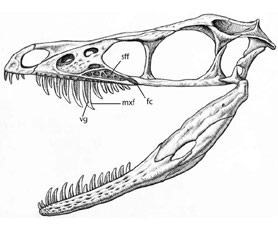| Location: Home > News > Events |
| Discovery News: Dinosaur Shocked Prey With Venom |
|
A birdlike dinosaur related to Velociraptor took down prey with its fanglike teeth.
Sinornithosaurus, a carnivorous Chinese dinosaur that likely feasted on other dinosaurs, was venomous, according to new analysis of its teeth and skull. While researchers in the past theorized some dinosaurs could inject venom into prey, this study, published in the latest issue of the Proceedings of the National Academy of Sciences, provides the most detailed evidence yet.
This line drawing features a reconstruction of the skull of Sinornithosaurus. The venom was secreted from a gland in its upper jaw, highlighted above, through its fanglike teeth. Sinornithosaurus, whose name means "Chinese bird lizard," lived during the Late Cretaceous Period from 99.6 to 65.5 million years ago. The researchers believe that other dromaeosaurid dinosaurs, such as Velociraptor, which were related to the bird-like Sinornithosaurus, might have also been venomous. One feature of Sinornithosaurus provided an obvious clue. "(Its front teeth) are so long and fanglike that the animal appears to be saber-toothed," Enpu Gong and his team wrote. Gong, a geologist at Northeastern University in Liaoning, China, and his team examined skulls of the dinosaur housed at China's Institute of Vertebrate Paleontology and Paleoanthropology, the Dalian Natural History Museum and the Tianyu Museum of Natural History. Detailed observations with microscopes revealed a never-before-seen feature: an upper jawbone with a space that likely housed a venom gland. Characteristics of the dinosaur's snake-like teeth suggest how the system worked. "This type of fang discharges venom along a groove on the outer surface of the tooth that enters the wound of the bitten animal by capillary action," Gong and his team said. "As in modern venomous taxa that employ grooved fangs, the ducts feed the venom to the base of the teeth." "We believe Sinornithosaurus was a venomous predator that fed on birds by using its long fangs to penetrate through the plumage and into the skin," they added, "and the toxins would induce shock and permit the victim to be subdued rapidly." In addition to birds, the raptor-like dinosaur also hunted pterosaurs, lizards, mammals and other dinosaurs, the scientists said. Similar to a modern day cobra, the Chinese dinosaur probably then employed a "bite and hold method of venom delivery," after which time the predator may have plucked off any feathers from its toxin-shocked prey and dismembered it using back teeth "that were shorter, broader, and more suitable for cutting." From http://news.discovery.com/dinosaurs/venomous-dinosaur-prey-teeth.html |
